

Jon Clements, Author (unless otherwise noted) and Editor
Current degree day accumulations
| UMass Cold Spring Orchard, Belchertown, MA |
18-April |
| Base 43 (SkyBit) | 240 |
| Base 50 (NEWA) | 61 |
Current bud stages. April 19, 2016, UMass Cold Spring Orchard, Belchertown, MA
 |
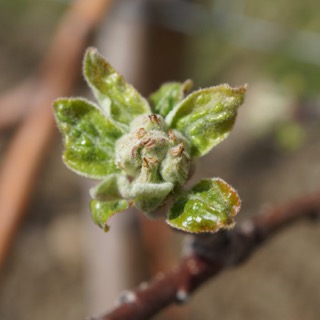 |
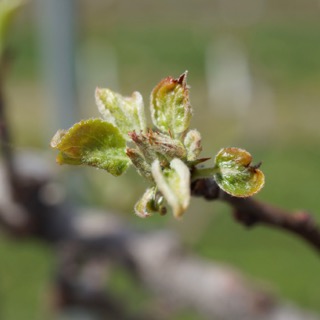 |
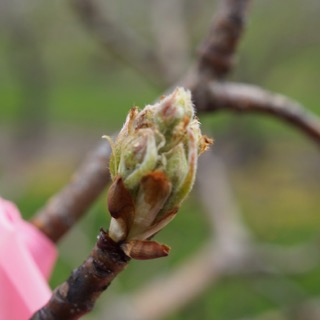 |
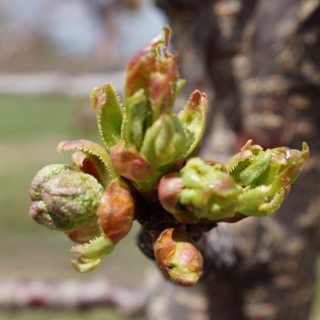 |
Honeycrisp apple early tight cluster |
McIntosh apple tight cluster |
Gala apple early tight cluser |
Golden russet bosc pear early bud burst |
Rainier sweet cherry bud burst |
| Coming events | Degree days (Base 43 BE) |
| European red mite egg hatch | 231-337 |
| Green apple aphid present | 111-265 |
| Green fruitworm peak flight | 97-209 |
| Obliquebanded leafroller larvae active | 158-314 |
| Oriental fruit moth 1st catch | 222-326 |
| Pear psylla 1st egg hatch | 174-328 |
| Redbanded leafroller 1st catch | 113-177 |
| Rosy apple aphid nymphs present | 134-244 |
| Spotted tentiform leafminer 1st oviposition | 143-273 |
| McIntosh at tight cluster | 206-258 |
20-April, 2016 (Wednesday) Fruit Twilight Meeting at The Big Apple Farm, 207 Arnold St., Wrentham, MA. 5:30 PM. In cooperation with Rhode Island Fruit Growers' Association. 1 pesticide credit will be offered. Light dinner will be served. $20 meeting fee. Contact: Jon Clements, 413-478-7219. Pre-registration is not necessary.
For more information and updates, see Upcoming Events
• You want the bad news first? After looking at a lot of apple buds, I am estimating the damage (from early April cold presumably) to individual buds (and spur leaves) to be approximately 50% across the board. It is now becoming more evident (w/o cutting) which buds are good and which are not. (See pictures below.) As we get into pink and bloom it will become even more clear. Now the good (better?) news? We're all in agreement if everything goes well for the next few weeks, there are plenty of live apple buds to set a crop. But, don't take any chances -- get bees in on on time, apply foliar nutrients, avoid applications of anything that might further damage spur leaves or buds (oil, copper, captan, surfactants, tank-mixes of almost anything, particularly a liquid crop protectant, etc.) Still, what happens from here-on-out is largely beyond our control so let's hope for some favorable weather at least. JC
• I also want to remind everyone that we (Extension specialists in New England) compiled an update to the 2015 New England Tree Fruit Management Guide. It, along with the 2015-16 New England Tree Fruit Management Guide (which is largely unchanged from 2015), is available here.
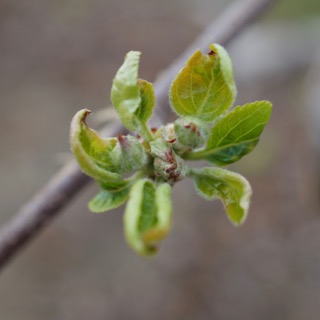 apple bud 19-April with 5-6 individul flowers; a bit out of focus, but note the middle buds are not separating and expanding (they are dead) but the two outer buds are moving |
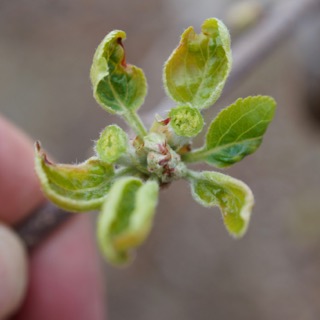 same apple bud pictured at left with two good buds cut open; note there is no browing at all; any sign of browning in a cut-open bud likely means it is no good |
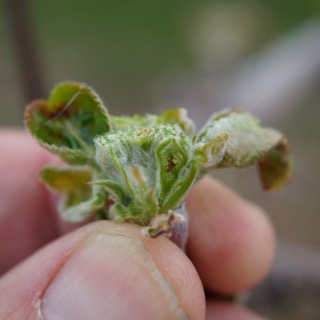 note flower bud on right sliced the long ways with dead ovary/style/stigma; no way this is going to set a fruit, even if it emerges with petals intact; other buds within the cluster may be undamaged |
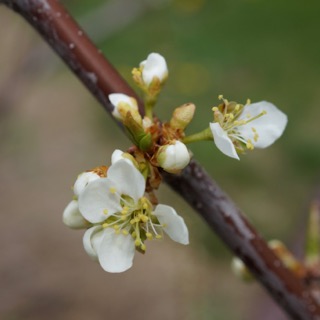 these test pluot selections are the only stone fruit with any bloom (to date, there may be some cherries still to come) at the UMass Orchard, 19- April; note however some missing petals, I suspect there is some cold damage (don't think they have fallen off yet) and un-emerged buds, but I can see a good, green style emerging (particularly evident in flower on right); these pluots are going to be worth lots of money this year (if I don't eat them)! |
• In addition to the Guest Article on disease contol in peaches without a crop, Dave Schmitt of Rutgers Cooperative Extension also answered a question on Apple-Crop about insect control in the same for this year. Here is his succinct but excellent response:
"As far as insect control goes, all that is needed is control Oriental Fruit Moth at least for the first and possibly second generation depending on the amount of pressure. Both Lesser and Greater Peach tree Borers should also be controlled. Scale and aphids should be monitored and controlled if needed, however if insecticide use is minimized this should not be an issue as beneficial insects would likely keep them in check. Herbicide programs should also be maintained to help control voles and to keep out broadleaf weeds to prevent the buildup of plant bugs. Everything is geared toward protecting the tree and minimizing pest pressure for next year’s crop. Hope this helps."
Winter moth update (April 17, Heather Faubert, URI) If you have a magnifying glass (10x is good) and you want to look for winter moth caterpillars, attached are a couple of pictures to help. Caterpillars are inside buds now, so to see winter moths, buds need to be peeled open. If a bud has caterpillars it is easier to find frass (insect poop) than caterpillars. Frass looks like small flecks of brown-black pepper in blueberry buds. In apples the frass can be reddish-brown to black. At URI's East Farm we sprayed March 30 for winter moth. We did not get very good control - though we don't know how many caterpillars would be there if we didn't spray. I think our poor control is due to winter moths hatching over a long period due to cool weather once eggs started hatching around March 27. Rain and snow washed off insecticide and the insecticide didn't last through the entire time eggs were hatching. We intend to spray apple trees and blueberries this coming week once fruit buds are at the tight cluster bud stage. Attached are pictures of apple and blueberry tight cluster.
|
Dan Cooley and Elizabeth Garofalo
Peaches. The chances of a peach crop are very low. Unless there are blossoms on a tree, there is little point in applying fungicides for brown rot. It’s still possible to get some stem infections, and for old cankers to reactivate, but this should not cause significant damage. A single application of captan or another relatively inexpensive fungicide should be sufficient to deal with peach diseases.
Scab spore maturity. This week's ascospore maturity numbers are as follows: In the squash mounts we are seeing 36% of the fruiting bodies sampled containing mature spore. The Petri plate assay came in with 27 spore observed and, most interestingly, 604 spore counted in the funnel trap. We did not check the two-fan trap as there has been no rain event to cause spore to release in the orchard. This extended dry spell we have been experiencing (more than seven days in a row at many locations) has slowed the maturity process for the ascospores this season. If we continue to see this dry weather, there is a chance we will be looking at a longer overall scab season this year. In the immediate future, however, you should be thinking about the first infection event of the season which will be coming up with out next rain event which, for Belchertown, looks like it might be this Friday with rain predicted to begin in the wee hours of the morning lasting through the day. I was recently reminded that in addition to the rain itself, the timing of that rain does play a factor. So, as I see it, in a low inoculum orchard, you can pretty safely hold off on your first spray until the next rain event after the one predicted for Friday. Those of you who have had scab in the past may want to get out there and get covered. Or you can use a post-infection approach.
Apple scab and post-infection sprays. Given the dry weather, it may be time to change advice regarding post-infection fungicides for apple scab. Last year, weather forecasts predicted a rain, the models predicted infection, and fungicides were applied. Then the rain, or at least enough rain to cause infection, never came. In retrospect, had growers relied more on post-infection spraying, they could have saved at least one or two sprays. However, we’ve recommended against post-infection spraying as it increases the risk of resistance development. However, in this dry spell, it may be worth reconsidering, for a few reasons. Consider the following:
If these rules can’t be met, it’s better to go with a protectant program, even at the risk of applying an unnecessary fungicide spray - better that than scab infections or resistant scab.
• A "spring tonic" spray of boron, zinc, and urea is particularly advised this year given freeze damage to apple buds. Timing is tight cluster. The formula is:
For more information, see: Prebloom Nutrient Applications for Apple Trees
• If you are not planting trees, you should be during this dry weather. Earlier planting is better.
• Pruning peaches w/o a crop? Proceed more or less normally -- remember, shade in the interior of a peach tree is your enemy. Concentrate on larger cuts to keep the light shining in. Reduce tree height. Reduce nitrogen application. I am seeing some tip injury to shoots from the winter -- you might want to hold off pruning for a bit to see what is starting to green-up. Summer pruning in particular this year is mandatory. (There won't be any peaches to hand-thin or pick, so you will have the time.)
Norman LaLancette, Rutgers Cooperative Extension
Reprinted from Plant & Pest Advisory, April 13, 2016
Ed. note: our peach crop loss occurred during the winter, not from the freeze in early April such that occurred in New Jersey. Still, the issues are the same when it comes to disease control in peaches without a crop. A thankless job for this year, but essential to maintain tree health for next year. JC
Cold injury to peach flowers and primordial fruit occurred during the evening of April 5-6 as temperatures dropped below freezing. At the Rutgers Agricultural Research and Extension Center, air temperatures first dropped below 32ºF at 10 pm Tuesday and remained below freezing until 9 am Wednesday morning. The lowest temperatures of 22 to 23 ºF occurred for four hours between 4 and 7 am. The average low temperature during the entire 12 hour cold period was 25.5 ºF.
The extent of injury to flowers and fruit varied by cultivar and stage of flower development. In our research blocks, the cultivars Bounty, O’Henry, Suncrest, Encore, and Autumnglo were assessed to have 5, 36, 59, 37, and 64% viable fruit, respectively. GaLa peach trees were not assessed, but appeared to have fruit loss similar to the Bounty.
Peach orchards that have little or no fruit still require disease control to avoid build-up of inoculum for the 2017 growing season. Below are recommendations for these orchards.
Scab. Although fruit infection is not a concern, spores from overwintering scab lesions will continue to infect the new current season shoots. These infections will result in overwintering lesions that will provide inoculum for the 2017 season. Thus, fungicide sprays need to be applied to protect these shoots.
Fungicide sprays should be applied until approximately 100 days after the pink stage, which will be early to mid-July for most cultivars in NJ. At this time, the current overwintering lesions cease to produce inoculum. A basic program would consist of captan or sulfur sprays beginning at early shuck-split (estimate this timing). If many scab lesions are present, an application of Gem or Abound at petal fall, shuck-split, or first cover would help to reduced inoculum levels by acting as an anti-sporulant.
Brown rot. If a small number of fruit are still present in the orchard, some of these fruit may become mummies, thereby providing primary inoculum for the 2017 growing season. This mummification is even more likely in the absence of preharvest fungicide sprays. However, no additional work need be performed as these mummies can be handled in the normal fashion.
Ideally, mummy removal is best during the fall by simply knocking them to the orchard floor where they will have time to decay before next spring. Removal of the mummies during spring pruning is another, perhaps more cost effective, option. However, unless removed from the orchard, these mummies will still sporulate on the orchard floor and provide inoculum for blossom blight.
Preferably, the fruit peduncle (fruit stem) should also be removed when detaching the mummy since it also provides inoculum. Knocking off the fruit often leaves the peduncle attached to the tree, so a knife cut along the stem would be required to remove both mummified fruit and stem. This operation may well be too laborious and costly. Thus, growers should be aware that they may have more infected peduncles next year in the canopy and make sure to apply a robust blossom blight program.
Bacterial spot. In a normal year with a crop, low doses of copper bactericides are typically applied during the post-bloom cover spray to protect fruit from infection. This program reduces the incidence and, in particular, the severity of disease development on fruit; there is much data to support this claim. However, these sprays rarely improve foliar health. While the copper may prevent some leaf infections, it also causes its own injury, and along with the bacterial spot not controlled, it contributes to defoliation. Furthermore, it has not been demonstrated that copper can prevent the formation of summer cankers on the current season’s new growth. Thus, copper is not recommended for orchards without fruit.
If a particular peach block consists of a highly susceptible cultivar, then it is possible that severe defoliation may occur in a disease-favorable growing season. Thus, these blocks should be closely monitored for the degree of disease development. If foliar infection appears to be increasing in severity (number of lesions; defoliation), then one or more applications of the antibiotic oxytetracycline (Mycoshield, FireLine) may be needed. For best results, these applications should be applied before warm (75-85ºF), wet, and windy conditions.
Constriction canker. The lack of fruit has no bearing on the development of constriction canker, which occurs exclusively on shoots. Thus, normal control practices should be followed. Canker removal during the summer, prior to leaf drop, and fungicide applications during fall and spring bud-break periods are recommended for susceptible cultivars currently harboring cankers. Further details can be found in the “Tree Fruit Pests and Controls” section of the 2016 New Jersey Commercial Tree Fruit Production Guide.
Follow me (jmcextman) on FB: https://www.facebook.com/jmcextman
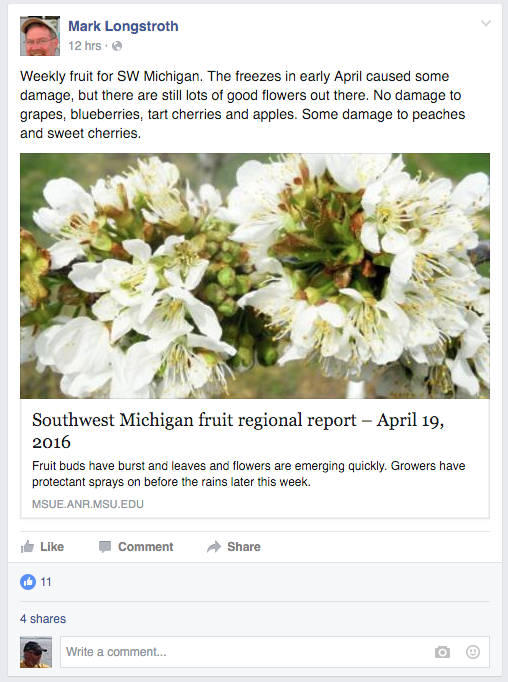
UMass Fruit Advisor: http://umassfruit.com
Scaffolds Fruit Journal: http://www.nysaes.cornell.edu/ent/scafolds/
Network for Environment and Weather Applications (NEWA): http://newa.cornell.edu
Follow me on Twitter (http://twitter.com/jmcextman) and Facebook (http://www.facebook.com/jmcextman)
The next Healthy Fruit will be published on Tuesday, April 26 or thereabouts, 2016. As always feel free to get in touch with any member of the UMass Fruit Team (http://extension.umass.edu/fruitadvisor/team-members) if you have questions or comments.